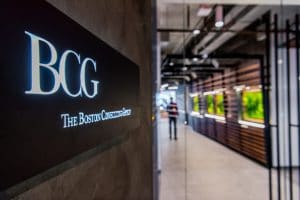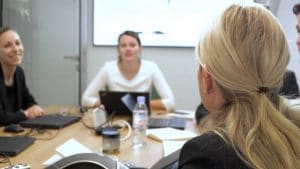Founded during the days of the Industrial Revolution in the 19th Century, there’s no denying that the management consulting industry has historically been male-dominated. The photograph below shows a group of McKinsey consultants at a conference in 1944.
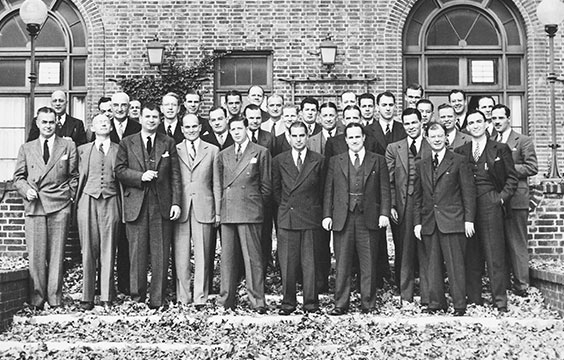
As times have changed, women have joined the ranks of consulting firms and many have pursued long and fulfilling careers. However, gender parity continues to remain a challenge within the industry.
With long working hours and a culture that’s not always conducive to the demands of a primary caregiver – a role that still tends to fall disproportionately to women – consulting firms have some way to go towards achieving a balanced gender population, especially at Partner level. Addressing this issue is a huge strategic focus for the world’s top-3 management consulting firms, McKinsey, BCG and Bain (collectively known as ‘MBB’), particularly when it comes to hiring new talent.
To learn more about the impact of these efforts, we conducted a detailed analysis of 7,550 candidates who were hired by the firms into client-facing roles in a selection of locations around the world between 2020 and mid-2022.
In this article we share the results of our analysis and answer the following questions:- How do MBB firms support female candidates?
- Which of the top-3 consulting firms are hiring the most women?
- Through which MBB recruitment channels are the most women hired?
- In which MBB geographies are the most women hired?
- What do the results mean for gender parity within the firms?
Key takeaways:
- McKinsey, Bain and BCG all have initiatives designed to support female candidates who are preparing to make an application.
- Progress is being made in gender parity in MBB hiring, with an average of 42% female hiring across all three firms.
- The difference in gender parity in hiring among the firms is small, with 44% female hiring at McKinsey and 41% at both BCG and Bain.
- Among the firms’ hiring channels, pre-experience student hiring is the closest to achieving gender parity, with 45% female hires across all the geographies analysed.
- MBA hiring is the recruitment channel furthest away from achieving gender parity, with only 38% of female hires across all geographies.
- MBB firms in the UK, Canada and Switzerland have achieved relative gender parity in hiring, while France and the Middle East have further to go.
- Achieving true gender parity within the ranks of top consulting firms – particularly at Partner level – isn’t just about hiring. Firms must nurture and support female consultants to ensure that they stand the same chance as men of being retained and promoted.
How MBB firms support female candidates
As part of their strategic efforts towards achieving gender parity, McKinsey, Bain and BCG all have initiatives designed to support and nurture female candidates who are preparing to make an application. These programs include:
- McKinsey’s Next Generation Women Leaders. This initiative gives female candidates in the APAC and EMEA regions the chance to network with McKinsey consultants and recruiters. The initiative also provides participants with learning sessions and an interview preparation program.
- BCG’s ASPIRE Women’s Workshop. This is a 3-day professional development event for university students in EMEA and South America. It involves a mix of inspiring keynotes, masterclasses, case workshops, fun activities and networking.
- Bain’s Connecting & Resourcing Empowered Women (CREW). This initiative allows second-year female undergraduates in the US to network and receive individual and group coaching. CREW also provides participants with the opportunity to interview for Bain’s summer Associate Consultant Internship (ACI) position.
Gender parity in hiring among the top-3 consulting firms
Our research indicates that the impact of these initiatives is starting to be seen at McKinsey, BCG and Bain. In the period covered by our analysis, the three firms achieved an average of 42% female hiring. While McKinsey came the closest to achieving gender parity, with 44% female hires, the difference among the firms was small, with 41% female hiring at both BCG and Bain.
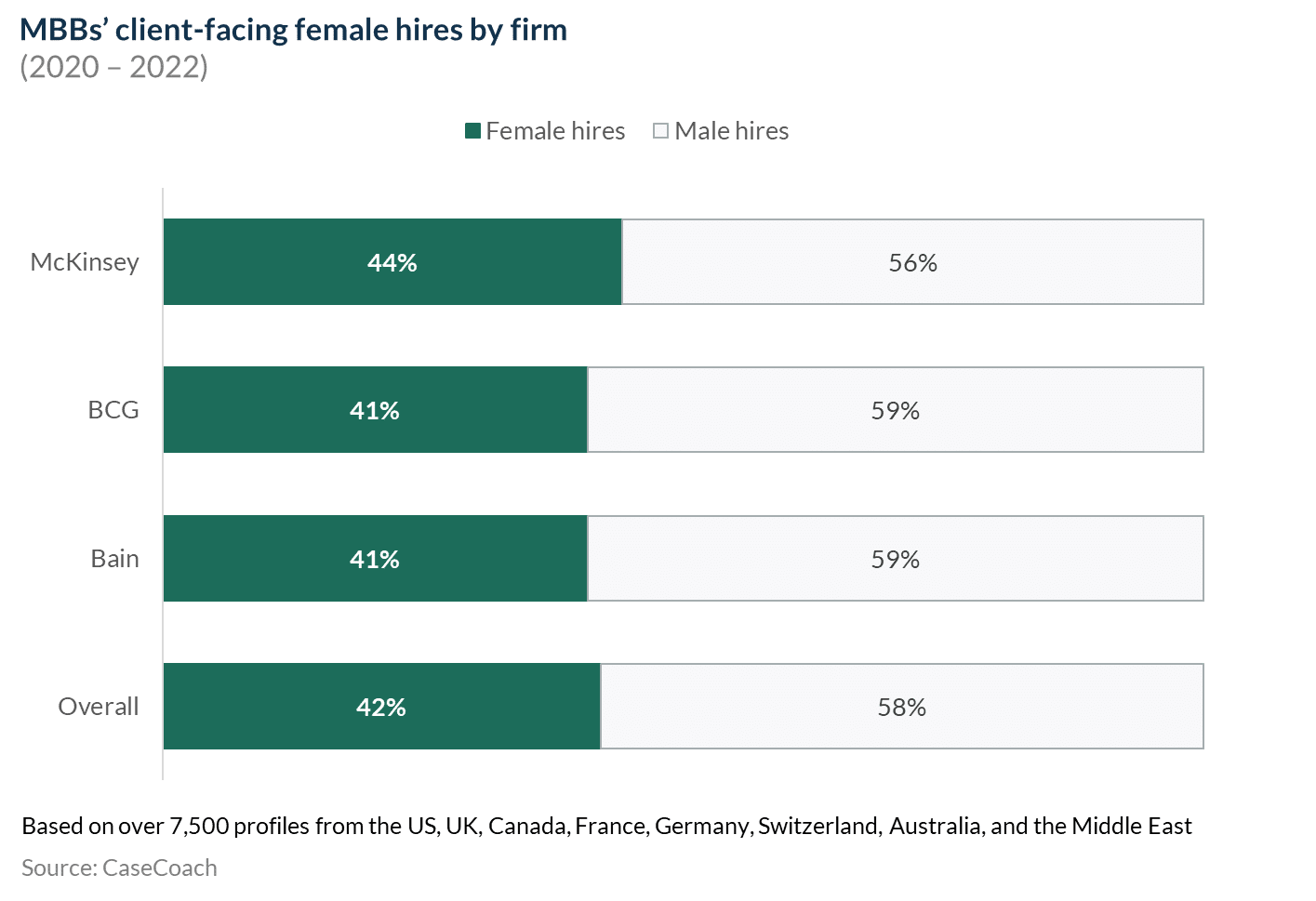
Gender parity in hiring across MBB recruitment channels
McKinsey, BCG and Bain all hire candidates from the following recruitment channels:
- Pre-experience student hires (with a bachelor’s degree or a non-MBA master’s degree) are recruited out of university or shortly after. They typically have no more than two years of experience and are hired into entry-level roles (i.e. Business Analysts at McKinsey, Associates at BCG and Associate Consultants at Bain).
- MBA hires are graduates of a one or two-year MBA program. They typically have some work experience, gained before their MBAs, and are hired into post-MBA roles (i.e. Associates at McKinsey and Consultants at BCG and Bain).
- Experienced hires are from other employers and typically have two to eight years of experience. Those with less are hired into pre-MBA roles (i.e. Senior Business Analysts at McKinsey, 2nd year Associate Consultants at Bain and Senior Associates at BCG). Those with significant experience are hired into post-MBA roles (i.e. Associates at McKinsey or Consultants at BCG and Bain).
- Advanced degree hires are hired during or soon (not more than two years) after their PhD or medical school programs. In the US, they’re typically hired into post-MBA roles, (i.e. Associates at McKinsey or Consultants at BCG and Bain). In some locations, they’re hired into senior pre-MBA roles (i.e. Junior Associates at McKinsey, 2nd year Associate Consultants at Bain and Senior Associates at BCG).
As the chart below illustrates, there is a marked difference in gender parity in hiring among these channels.
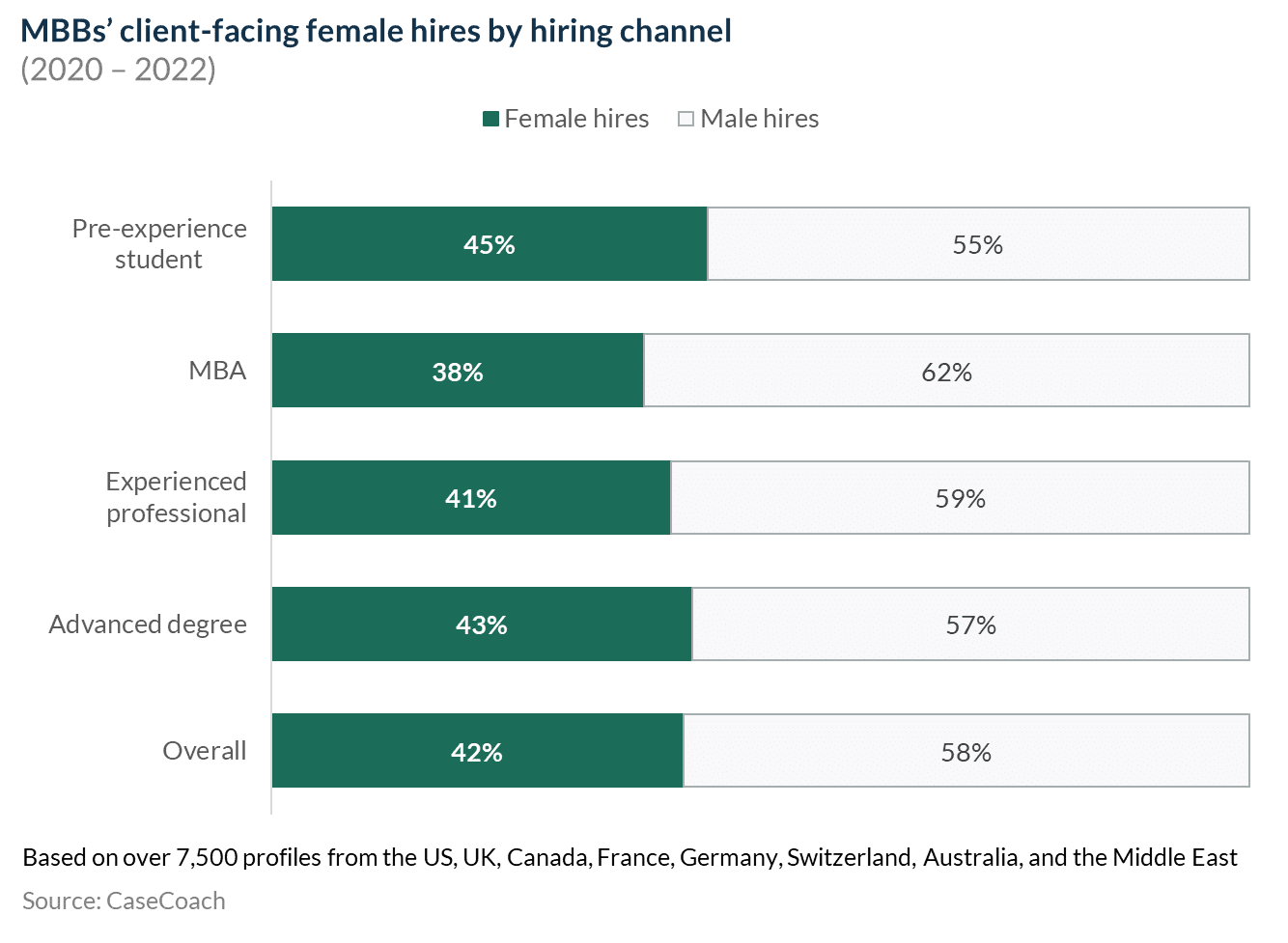
Pre-experienced student hiring is the recruitment channel that came the closest to achieving gender parity in our analysis, with 45% female hires. Other channels have much further to go. This is particularly true of MBA hiring, where only 38% of all hires were women. However, it’s worth noting that there is currently an inherent gender disparity in the MBA candidate pool. The female intake of Columbia Business School’s 2022 MBA program was 44%, while a typical class profile at INSEAD is only 38% female.
Gender parity in MBB hiring across different locations
Gender parity in hiring differs among geographies
As the chart below illustrates, we observed some big differences in the gender parity in hiring in each of the global MBB locations included in our analysis.
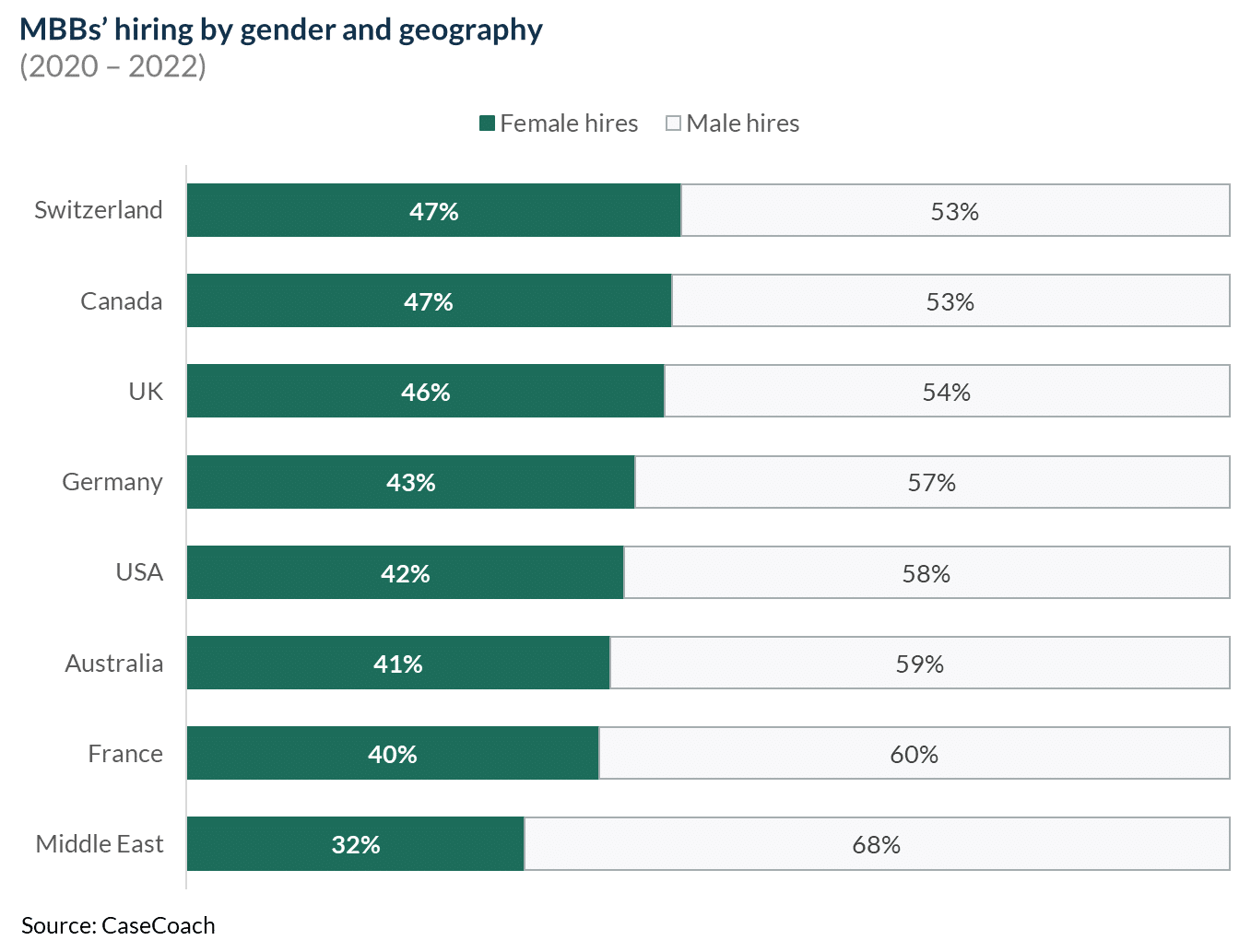
While none of the locations achieved true gender parity in hiring, some came close. In Switzerland and Canada, 47% of all MBB hires were women, while in the UK it was 46%.
Other locations have further to go. In France, for example, only 40% of MBB hires were women. In the World Economic Forum’s 2022 gender gap report, France is ranked 15th in the world – above the UK, the US and Canada – for dimensions including economic opportunities and education. We therefore might have expected to see a higher percentage of female hiring at MBB firms in France.
However, when we look at the educational programs that the candidates who make it to McKinsey, BCG and Bain in France attended, we see an inherent gender disparity in the candidate pool. HEC Paris was the source of the highest percentage of pre-experienced student and MBA hires at MBB firms in France. In the 2022 class of its Master in Management course, women only accounted for 45% of the student population. Meanwhile, just 34% of the school’s MBA graduates in 2022 were female.
Perhaps less surprisingly, the location that was furthest away from achieving gender parity in our analysis was the Middle East, with only 32% female hiring. The World Economic Forum’s gender gap report illustrates greater disparity there; the United Arab Emirates was ranked the highest of all the countries in the Middle East, in only the 68th position. The gender disparity in MBB hiring in this part of the world may also be reflective of a broader reality about the inclusion of women in the workplace. In addition, it may point to the comparative difficulty these offices are likely to have in attracting international female candidates.
Gender parity in hiring in the US differs among offices
While country-level figures might suggest that MBB firms in some locations are close to achieving gender parity, office-level figures sometimes tell a different story. In the US, 42% of MBB firms’ total hires were female. However, there are notable differences in gender parity among the firms’ offices in different parts of the country, as the chart below illustrates.
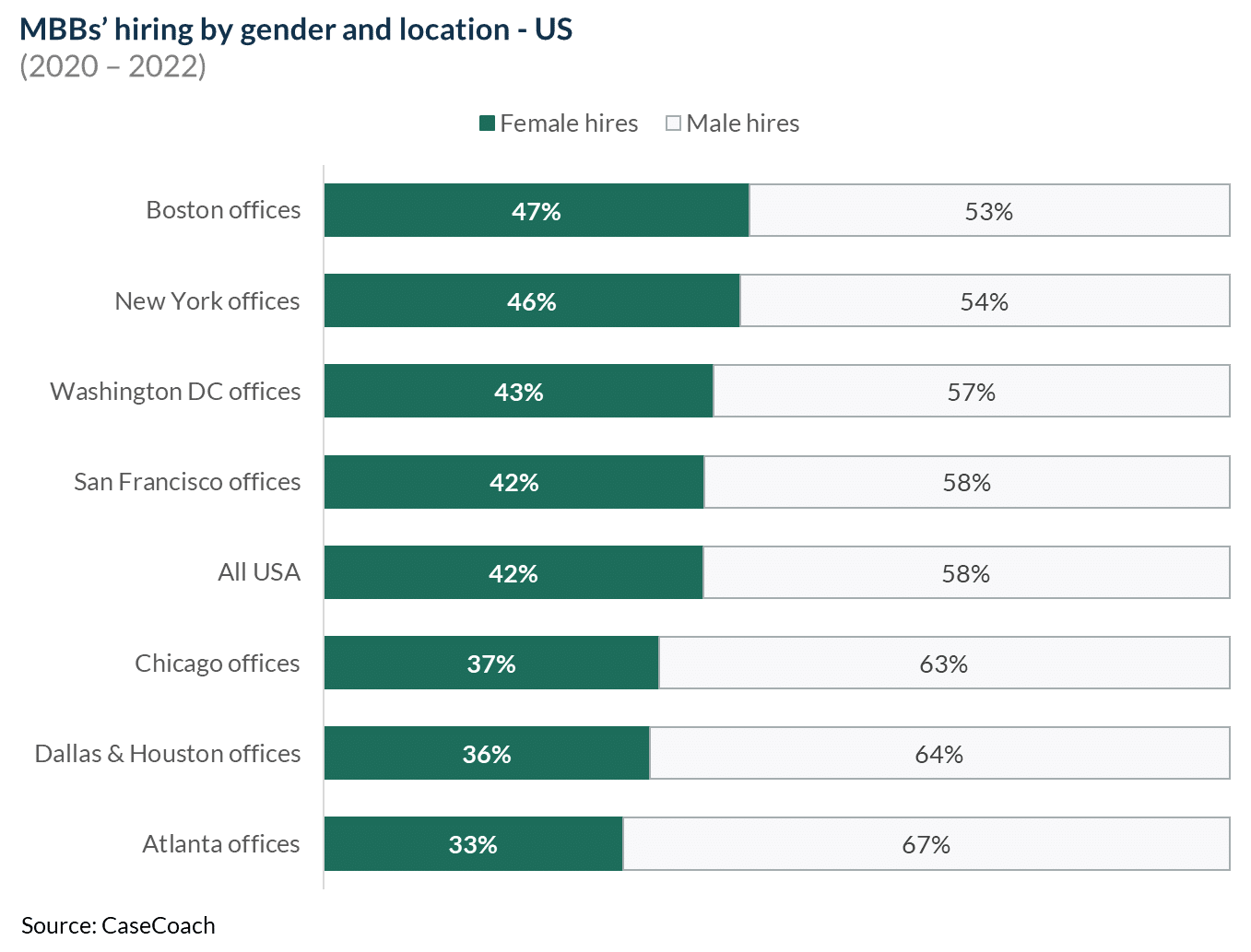
MBB firms in the North-East (i.e. Boston, New York, Washington DC) came closer to achieving gender parity than the national average of 42%, with 47%, 46% and 43% female hiring respectively.
However, MBB firms’ offices in the South (i.e. Dallas & Houston and Atlanta), were further away from achieving gender parity than both the US as a whole (42%) and France (40%), with only 36% and 33% female hiring respectively.
As the firms’ recruitment efforts are consistent across the US, this data could indicate that top female candidates are more drawn to management consulting careers in some parts of the country than others.
What the results mean for gender parity within the firms
Our analysis shows that McKinsey, Bain and BCG’s efforts towards achieving gender parity are generating some tangible results.
The three firms averaged 42% female hiring, while the population of their pre-experienced student hire channel was 45% female. And while some MBB locations – such as France and the Middle East – have further to go, the UK, Switzerland and Canada are all very close to achieving a balanced population of male and female hires.
When it comes to achieving true gender parity within the ranks of top consulting firms, however, hiring is only part of the picture. The management consulting industry may no longer be entirely dominated by men but the experience of being a woman at McKinsey, Bain or BCG is not without its challenges, even today.
The firms all have initiatives in place to address this. McKinsey Women, Women@BCG and Womxn at Bain (WAB) are designed to help female consultants find mentorship, support and guidance from one another.
While this is a good foundation to build on, the firms need to continue nurturing and supporting female consultants to ensure that they stand the same chance as men of being retained and promoted. Only then will the firms achieve the ultimate goal of true gender parity at every level, with an equal balance of male and female Partners.
What’s next if you’re looking to join a top consulting firm
If you’re looking to join a top consulting firm like McKinsey, BCG or Bain, CaseCoach has resources to guide you all the way through the process, from crafting your resume to preparing for your final interviews.
Our Free Resume Course provides resume and cover letter templates and specialized advice for students, MBAs and experienced professionals.
The Consulting Interview Prep Toolkit contains all the resources you need to ace your case and fit interview, including online courses, sample interviews, case material and practice tools.
Our team of coaches includes former consultants and interviewers with McKinsey, BCG, and Bain. They are available to deliver case and fit interview coaching and mock interviews in a realistic setting to put your preparation to the test, providing personal feedback and practical advice to help you ace your interviews.




